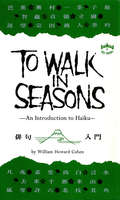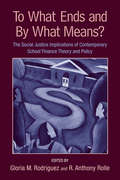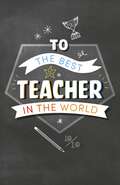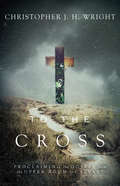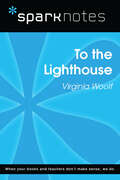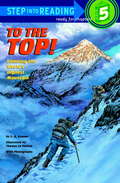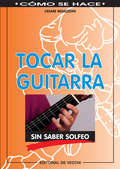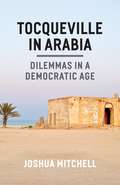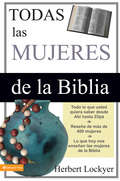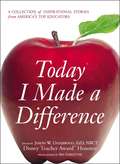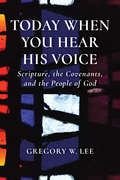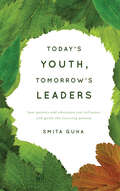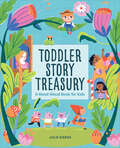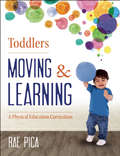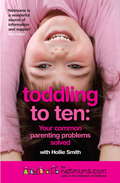- Table View
- List View
To Walk in Seasons: An Introduction to Haiku
by William Howard CohenTo Walk in Seasons is designed to help the beginner discover haiku for himself, and eventually create his own haiku poems.It includes a lively and sensitive introduction on the nature of haiku.<P><P> For individual study, or for use in the classroom, it also contains a study guide aimed at recreating the thought processes behind this terse, concentrated form. Mr. Cohen's poetry like his anthology illuminates poetic experience:To walk in seasonsis to discover what's insidea split instantTo walk in seasons;passing through a dry gateinto a rainstorm.To walk in seasons is to wake andfind you really are.Mr. Cohen's haiku and other poems have appeared in many well-known literary periodicals such as Literature East and West and American Haiku. He is the author of The Hill Way Home and A House in the Country, and his works have been praised by such eminent poets as Peter Viereck and Mark Van Doren. (He was elected in 1963 to membership in the Poetry Society of America) Mr. Cohen won the title of United States Olympic Poet, representing the United States in Mexico City in 1968, and in 1969 he honored at the World Congress of Poets in Manila.
To Want to Learn
by Jackson KytleLack of learner motivation is the single greatest challenge before American schools and colleges. When students are self-motivated, they invest more and work harder at learning even if resources are inadequate. Jackson Kytle's provocative book argues that students and teachers waste time and human energy because the conventional curriculum rests on flawed mental models. Hope for change requires a searching critique of modernity as well as expanded theories of human motivation and learning based on advances in neurobiology and cognitive studies. After consideration of existentialism and choice of life purposes, and the dynamics of psychological involvement, Kytle closes his ambitious, interdisciplinary book with ten considerations for better learning.
To What Ends and By What Means: The Social Justice Implications of Contemporary School Finance Theory and Policy
by Gloria M. Rodriguez R. Anthony RolleThis unique collection examines the social justice implications of contemporary economic, finance, and budgeting policies affecting the K-12 education system in the United States. The authors included in this volume provide critiques and explorations of several established theories and policy approaches that undergird contemporary thinking in the field of school finance. These explorations offer themselves as foundations for building new frameworks to understand how school finance policies might better support broader changes needed to improve the educational conditions faced by those individuals and groups traditionally underrepresented in economic, political, and social policy arenas.
To Whom Do Children Belong?
by Melissa MoschellaMost people believe that parents have rights to direct their children's education and upbringing. But why? What grounds those rights? How broad is their scope? Can we defend parental rights against those who believe we need more extensive state educational control to protect children's autonomy or prepare them for citizenship in a diverse society? Amid heated debates over issues like sexual education, diversity education and vouchers, Moschella cuts to the heart of the matter, explaining why education is primarily the responsibility of parents, not the state. Rigorously argued yet broadly accessible, the book offers a principled case for expanding school choice and granting exemptions when educational programs or regulations threaten parents' ability to raise their children in line with their values. Philosophical argument is complemented with psychological and social scientific research showing that robust parental rights' protections are crucial for the well-being of parents, children and society as a whole.
To Write Good Tamil: நல்ல தமிழ் எழுத வேண்டுமா
by A. K. Paranthaamanarதமிழ்மொழி, ஆட்சி மொழியாகும் காலம் நெருங்கி விட்டது. தமிழ் வெளியீடுகளும் நாளிதழ்களும் நல்ல தமிழில் வெளிவரல் வேண்டும். எழுத்தாளர்கள் பிழையின்றி எழுத வேண்டுமானால், ஓரளவு நடைமுறை இலக்கணம் தெரிந்து கொள்ளுதல் இன்றியமையாதது. இந்நூலாசிரியர் நீண்ட கால அனுபவம் வாய்ந்தவர். எனவே பெருவரவாகக் காணப்படும் பிழைகளை இவர் இந்நூலில் எடுத்துக் காட்டித் திருத்தங்களையும் கொடுத்துள்ளார்; வல்லெழுத்துமிகும் இடங்களையும் மிகாத இடங்களையும் எளிய முறையில் விளக்கியுள்ளார்; சந்தி முறைகளை மிக எளிதாகக் காட்டியுள்ளார்; சொற்றொடர்ப்பிரிப்புகளில் ஏற்படும் தவறுகளை எடுத்துக்காட்டி விதிகளையும் வகுத்துள்ளார். ஆதலால், நல்ல தமிழ் எழுத விரும்பும் பலர்க்கும் இந்நூல் பயன்படக்கூடியது
To the Best Teacher: Perfect End of Year Gift | Retirement & Appreciation - Thank You Teacher for Helping Me
by Pop Press'Education is the most powerful weapon which you can use to change the world' Nelson Mandela A card isn't quite enough - how can you say 'thank you' to some of the unsung heroes of our time? A good teacher can turn a life around. A good teacher can change the course of a career. A good teacher can bring the best out of every student. A good teacher deserves to be celebrated. This is a gift - to the teachers who have taken the time to help us understand or appreciate a subject. To the teachers who believed in us even when we didn't believe in ourselves. To the teachers who have taught us so much more than a subject. To the teachers we will never forget. This is a gift to the best teacher.
To the Cross: Proclaiming the Gospel from the Upper Room to Calvary
by Christopher J. WrightThe cross is good news for us today.
To the Lighthouse (SparkNotes Literature Guide Series)
by SparkNotesTo the Lighthouse (SparkNotes Literature Guide) by Virginia Woolf Making the reading experience fun! Created by Harvard students for students everywhere, SparkNotes is a new breed of study guide: smarter, better, faster. Geared to what today's students need to know, SparkNotes provides: *Chapter-by-chapter analysis *Explanations of key themes, motifs, and symbols *A review quiz and essay topicsLively and accessible, these guides are perfect for late-night studying and writing papers
To the Top!: Climbing The World's Highest Mountain (Step into Reading #Vol. 5)
by Sydelle KramerIllus. in full color. Here is the gripping story of Hillary and Norgay's perilous ascent of Mount Everest as they battled snow and ice slides, whipping winds, and the grim knowledge that 19 others had died in the same attempt.
Toby Goes Bananas: A Graphic Novel
by Franck GirardToby is last in class but first on the playground!Toby may be the class clown, but he's smart enough to know what's what. Whether he's late for school, early for recess, or just in time to fail the next quiz, he's always got something to say about it. But even though his friends think he's funny, the adults in his life aren't laughing--mostly because they're not in on the jokes. No matter! Toby makes the best of it as he coasts through the day on his wit and good humor!
Tocar la guitarra sin saber solfeo
by Cesare Regazzoni* Los acordes son la base del acompañamiento musical. Una vez los haya aprendido, usted podrá desarrollar su técnica con mucha más seguridad y rapidez. Interpretar una melodía o acompañar a un cantante le será muy fácil. * En esta guía usted encontrará todos los acordes y sus respectivos «giros» o combinaciones, representados en sencillas ilustraciones en las que podrá reconocer fácilmente las cuerdas de la guitarra y la posición de los dedos. No encontrará ni un solo pentagrama, ni una nota, porque estas páginas están pensadas para que cualquier persona, aun no sabiendo solfeo, pueda aprender a tocar la guitarra. * Lo importante en este libro no es la teoría, sino la práctica, por ello sólo se dan las indicaciones más útiles y eficaces. * Un manual, en resumidas cuentas, que le ayudará a dar los primeros pasos con el instrumento más adecuado para animar las fiestas, acompañar a los amigos cuando vaya de excursión y alegrar el ambiente en muchas ocasiones Cesare Regazzoni se diplomó en el conservatorio de Parma en canto oral, instrumentos de viento y de percusión y composición con los profesores Margola y Milan. Ha grabado numerosos discos de didáctica infantil con fascículos de animación. En el año 1987 realizó para RAI 2 las bandas sonoras de seis largometrajes para el Festival de Cine de Venecia. En el año 1990 colaboró con RAI 3 en el Departamento de Escuela - Educación. Desde hace varios años trabaja y produce en su estudio personal de grabación donde ha conseguido una amplísima experiencia con el teclado electrónico.
Tocqueville in Arabia: Dilemmas in a Democratic Age
by Joshua MitchellThe Arab Spring, with its calls for sweeping political change, marked the most profound popular uprising in the Middle East for generations. But if the nascent democracies born of these protests are to succeed in the absence of a strong democratic tradition, their success will depend in part on an understanding of how Middle Easterners view themselves, their allegiances to family and religion, and their relationship with the wider world in which they are increasingly integrated. Many of these same questions were raised by Alexis de Tocqueville during his 1831 tour of America, itself then a rising democracy. Joshua Mitchell spent years teaching Tocqueville's classic account, Democracy in America, in America and the Arab Gulf and, with Tocqueville in Arabia, he offers a profound personal take. One of the reasons for the book's widespread popularity in the region is that its commentary on the challenges of democracy and the seemingly contradictory concepts of equality and individuality continue to speak to current debates. While Mitchell's American students tended to value the individualism of commercial self-interest, his Middle Eastern students had grave doubts about individualism and a deep suspicion for capitalism, which they saw as risking the destruction of long-held loyalties and obligations. When asked about suffering, American students answered in psychological or sociological terms, while Middle Eastern students understood it in terms of religion. Mitchell describes modern democratic man as becoming what Tocqueville predicted: a "distinct kind of humanity" that would be increasingly isolated and alone. Whatever their differences, students in both worlds were grappling with a sense of disconnectedness that social media does little to remedy. We live in a time rife with mutual misunderstandings between America and the Middle East, and Tocqueville in Arabia offers a guide to the present, troubled times, leavened by the author's hopes about the future.
Todas las mujeres de la Biblia
by Herbert LockyerEl Dr. Lockyer provee un comentario apropiado sobre todas las mujeres conocidas —y no tan conocidas— de la Biblia. Descubrirá cómo la vida y el carácter de diferentes mujeres de la Biblia reflejan las situaciones de la mujer de la actualidad. Más de cuatrocientas entradas concisas y llenas de datos ciertos, que proporcionan una perspectiva fascinante y motivan a pensar. De gran utilidad ya sea que esté conduciendo un estudio bíblico en grupos, hablando en público o simplemente profundizando tu conocimiento personal de Dios.
Today I Made a Difference
by Joseph W UnderwoodEveryone remembers that teacher who made a difference. The one who went the extra mile to truly affect lives, whose lessons carried as much importance outside the classroom as inside. This book is a celebration of those teachers who continue to make an impact. A collection of stories from some of the country's top educators, this book is a celebration of teachers' work, and motivation for them to continue. Joseph Underwood has collected stories from each of the twenty-eight 2004 Disney TeacherTM of the Year honorees. And every story celebrates a different obstacle they overcame, the power and know-how needed to triumph, and the reward granted upon beating the odds. It's the perfect gift for anyone in or considering the profession. This collection is sure to inspire, celebrate, and motivate those people who make the biggest difference in everyone's life.
Today I Made a Difference: A Collection of Inspirational Stories from America's Top Educators
by Joseph W UnderwoodEveryone remembers that teacher who made a difference. The one who went the extra mile to truly affect lives, whose lessons carried as much importance outside the classroom as inside. This book is a celebration of those teachers who continue to make an impact. A collection of stories from some of the countryÆs top educators, this book is a celebration of teachersÆ work, and motivation for them to continue. Joseph Underwood has collected stories from each of the twenty-eight 2004 Disney TeacherTM of the Year honorees. And every story celebrates a different obstacle they overcame, the power and know-how needed to triumph, and the reward granted upon beating the odds. ItÆs the perfect gift for anyone in or considering the profession. This collection is sure to inspire, celebrate, and motivate those people who make the biggest difference in everyoneÆs life.
Today I Made a Difference: A Collection of Inspirational Stories from America's Top Educators
by Joseph W. UnderwoodThis collection of stories from some of the country's top educators- telling of obstacles they've overcome, the strength and skill needed to triumph, and the rewards reaped for beating the odds - both celebrates teachers' work, and provides inspiration for teachers and potential teachers alike to continue their impactful work.
Today When You Hear His Voice: Scripture, the Covenants, and the People of God
by Gregory W. LeePresents a doctrine of Scripture based on Hebrews in dialogue with Augustine and Calvin What vision of biblical authority arises from Scripture’s own use of Scripture? This question has received surprisingly little attention from theologians seeking to develop a comprehensive doctrine of Scripture. Today When You Hear His Voice by Gregory W. Lee fills this gap by listening carefully to the Epistle to the Hebrews. Lee illuminates the unique way that Hebrews appropriates Old Testament texts as he considers the theological relationship between salvation history and scriptural interpretation. He illustrates these dynamics through extended treatments of Augustine and Calvin, whose contrasting perspectives on the covenants, Israel, and the literal and figural senses provide theological categories for appreciating how Hebrews innovatively presents Scripture as God’s direct address in the contemporary moment.
Today When You Hear His Voice: Scripture, the Covenants, and the People of God
by Gregory W. LeePresents a doctrine of Scripture based on Hebrews in dialogue with Augustine and Calvin What vision of biblical authority arises from Scripture&’s own use of Scripture? This question has received surprisingly little attention from theologians seeking to develop a comprehensive doctrine of Scripture. Today When You Hear His Voice by Gregory W. Lee fills this gap by listening carefully to the Epistle to the Hebrews. Lee illuminates the unique way that Hebrews appropriates Old Testament texts as he considers the theological relationship between salvation history and scriptural interpretation. He illustrates these dynamics through extended treatments of Augustine and Calvin, whose contrasting perspectives on the covenants, Israel, and the literal and figural senses provide theological categories for appreciating how Hebrews innovatively presents Scripture as God&’s direct address in the contemporary moment.
Today's Teen (5th edition)
by Eddye Eubanks Joan Kelly-PlateRelationships, home management, money, grooming, housing, interior design, clothing, food, career selection and applying for a job form the main topics of this home economics textbook.
Today’s Guide to Educational Policy: Pandemics, Disasters, Nationalism, Religion, and Global Politics
by Joel SpringIn his latest book, Joel Spring covers major political, economic and social issues affecting US and global education policy today. Crafted to evoke classroom discussion, this book explores contemporary issues such as the pandemic, institutional racism, religious controversies, nationalism and immigration, increased reliance on online instruction, climate change, economics of education and the deep state in education. Giving students the opportunity to engage in critical thinking and explore the growing sense that US and global education is in distress and in need of fundamental transformation, this book forces readers to examine their own values and how they might apply this thinking to their own education policy and practice.
Today’s Youth, Tomorrow’s Leaders: How Parents and Educators Can Influence and Guide the Learning Process
by Dr Smita GuhaToday’s Youth, Tomorrow’s Leaders is for parents, teachers, caregivers, directors, educators, administrators and all who work with children to encourage learning. This book has examples of effective practices in early childhood education from different countries worldwide. This book will emphasize the different ways that adults can make difference in the lives of children so that today’s children will be well nurtured and will become effective citizens in future. The structure of the book is adapted to the new Early Childhood Common Core. The book has case studies, illustrations, pictures, and tables to help the readers. Each chapter will also have a summary at the end with discussion questions.
Toddler Story Treasury: A Read Aloud Book for Kids
by Julie KierasRead cherished classic stories aloud—for toddlers ages 1 to 3 Toddlers love listening to a story, especially when it's read by someone they love. But how can you fit this beloved tradition into a busy day or night? This toddler reading book offers much-loved tales that are shortened, so it's easy to make time for them—even if your toddler asks for "just one more." Cozy up with 30 stories—Delight your toddler with classic tales to enjoy over and over again, including "The Three Little Pigs," "The Little Duckling," "Beauty and the Beast," "Tom Thumb," and many more. Enchanting pictures tell the story—Discover whimsical illustrations that enhance the playfully retold condensed tales. Teach skills with stories—Experience how reading aloud helps kids build vocabulary, grow emotionally, and learn effective listening. Give a gift more fitting than a glass slipper: reading aloud from this storybook for toddlers.
Toddlers Moving and Learning
by Rae PicaMore than 50 movement activities for toddlersPhysical education is a critical part of every early childhood curriculum. Children need to move to channel their energies in creative, beneficial ways and to learn habits for lifelong health and fitness. Toddlers Moving & Learning provides more than 50 developmentally appropriate activities that contribute to a well-rounded curriculum in any classroom or program.The book containsAn updated introduction reflecting new research and trends in early childhood health and fitness and information on how movement benefits children's learning and developmentFourteen lesson plans, each with one body parts activity, one nonlocomotor activity, one locomotor skill experience, and one activity exploring an element of movement, for a total of 56 activitiesExtension ideas and adaptations to use with children who have special needsCurriculum connections for each activity and explanations about how activities are aligned with and meet early learning standards from NAEYC and AAHPERDOriginal music to add joy and energy to the activities
Toddling to Ten: Your Common Parenting Problems Solved: The Netmums Guide to the Challenges of Childhood
by Netmums Hollie Smith Siobhan FreegardHow do you avoid pyjama dramas and get a toddler to play ball at bedtime? How do you manage your child's time on the computer and kids who are couch potatoes? What do you do when your five year old starts telling lies? All the answers can be found in this comprehensive guide to coping with the challenges of childhood. A hand-selected panel of experts ranging from dentists to psychologists provide scholarly advice. But, crucially, there are hundreds of top tips and suggestions from other mums - the members of netmums.com, the rapidly-growing online community of mothers sharing valuable information on all aspects of childcare. It's real advice for real women, and is guaranteed to put the fun back into family life.
Todo el mundo cabe aquí
by Alexandra PenfoldA Spanish edition of ALL ARE WELCOME! Join the call for a better world with this New York Times bestselling picture book about a school where diversity and inclusion are celebrated. Discover a school where--no matter what--young children have a place, have a space, and are loved and appreciated.Follow a group of children through a day in their school, where everyone is welcomed with open arms. A school where students from all backgrounds learn from and celebrate each other's traditions. A school that shows the world as we will make it to be.
